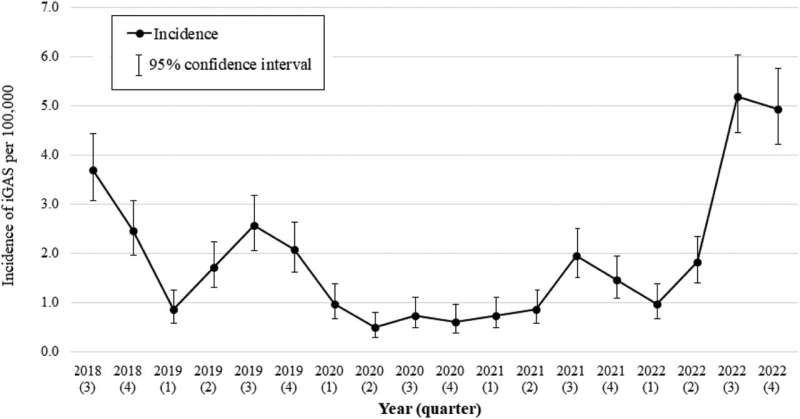Australia has experienced an intense surge in severe Strep A cases, similar to the northern hemisphere wave, despite differences in seasons and circulating respiratory viruses, according to a new study.
The national research project, involving researchers from Murdoch Children's Research Institute and published in The Lancet Regional Health—Western Pacific, highlighted how the unseasonal increase in case load across the southern hemisphere adds to the need for a safe and effective vaccine against Strep A.
The common deadly bacteria causes sore throats, scarlet fever and skin sores. Strep A infections affect about 750 million people and kills more than 500,000 globally every year, more than influenza, typhoid or whooping cough. Strep A can also cause severe life-threatening infections including toxic shock syndrome and flesh-eating disease as well as the post-infectious illnesses of acute rheumatic fever, rheumatic heart disease and kidney disease.
Strep A infections disproportionately affect young children, the elderly, pregnant women and Indigenous Australians. Rates of acute rheumatic fever and rheumatic heart disease among Indigenous populations in northern Australia are some of the highest in the world. Currently, there is no vaccine available to prevent Strep A.
For the study, the Paediatric Active Enhanced Disease Surveillance (PAEDS) Network collected data of children, under 18 years, admitted to five major Australian pediatric hospitals with severe Strep A infections. Strep A in Australia increased sharply from mid-2022 after a reduction in cases during 2020 and 2021. Cases jumped from 23 in 2020 to 107 by 2022. The incidence rate among Aboriginal and Torres Strait Islander children was twice that of non-indigenous children.
Murdoch Children's Dr. Yara-Natalie Abo said Australia had followed similar trends in the UK, US and western Europe during 2022, despite differences in climate, seasons and circulating viruses.
"Increases in Strep A cases have been reported around the world, occurring during, and outside of, typical spring peaks," she said. This increase is likely due to a combination of environmental factors and viruses in circulation and more research is needed into whether new strains might be responsible.
"Strep A most commonly causes mild symptoms like sore throat, but in some children it can cause life threatening sepsis which requires early recognition and treatment. The global burden of Strep A is an unmet public health challenge."
Dr. Abo said reduced social contact during the COVID-19 pandemic may have also impacted on children's immunity to Strep A.
"Children normally get seasonal exposures to colds and common infections like Strep A, but lockdowns and other restrictions such as mask mandates during the COVID pandemic limited social contact for almost three years," she said. "This may have contributed to a lowered immunity and a spike in invasive Strep A infections as we emerged from lockdowns."
The hospital data showed the extent of symptoms among children admitted with Strep A, including toxic shock syndrome and aggressive skin infections.
Sandeep Kaur's daughter, Gursirat, 1, spent almost two months in intensive care earlier this year after contracting a Strep A infection.
"Gursirat had a mild fever, but otherwise was fine, so we gave her pain relief and kept an eye on her," Sandeep said. "But three days later she fell suddenly very ill. Her hands, lips and feet turned blue and her skin was discolored."
Sandeep said after she was admitted to hospital, Gursirat's condition worsened. She was diagnosed with kidney failure, a liver infection, and necrosis on seven of her fingertips, all linked to the Strep A infection.
"It was such a difficult time, our baby had drains in her leg, needed two operations and required dialysis for 12 days," she said. "Thankfully, her fingertips were saved but she is yet to fully recover. I hope that a vaccine can be made for Strep A so no other child has to endure this."
Murdoch Children's Professor Andrew Steer said the study found more children were presenting with severe symptoms as a result of Strep A infections.
"More research is required into the causes of this spike and how we can prevent future surges," he said. "With ongoing funding, we can begin to answer some of these complex questions and work towards an effective and accessible Strep A vaccine."
Professor Steer and his team are testing candidate Strep A vaccines developed by researchers in Australia and overseas in a first of its kind human challenge model.
The trials, which are planned to be conducted in Melbourne, involve about 50 participants receiving a candidate vaccine or placebo and having Strep A applied on their throats in a controlled environment.
"We hope this research will accelerate the development of a vaccine and move things forward to bigger field trials," Professor Steer said. A vaccine for Strep A will save hundreds of thousands of lives every year and prevent millions of infections that send children and adults to the hospital or doctor."
- Karlston
-

 1
1



Recommended Comments
There are no comments to display.
Join the conversation
You can post now and register later. If you have an account, sign in now to post with your account.
Note: Your post will require moderator approval before it will be visible.